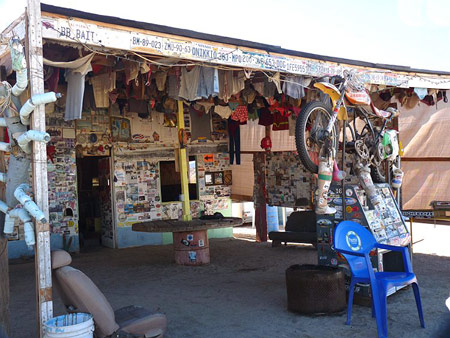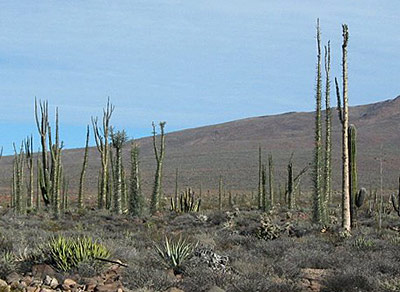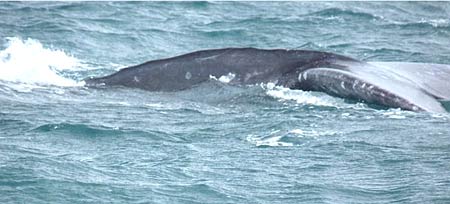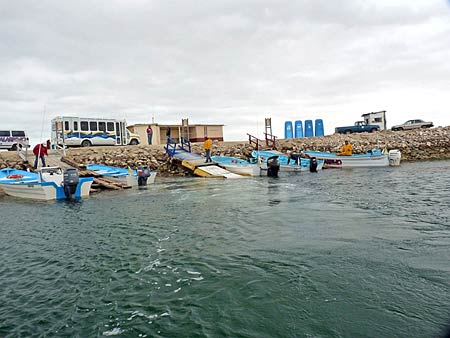
Guerrero Negro/Scammon's Lagoon/Whale Watching - 2014
It was only after Charles and Loretta Henry extended an invitation to join them on a whale-watching trip I realized, with a certain amount of embarrassment, that there weren't enough baleens in my life. In fact except for a minke whale I helped roll off a sand bar forty years ago, there were none. So of course I accepted.
The shortest line between two points is always a tempting way to travel, but when those points live in Baja you should expect a certain amount of automotive triage at the end of the journey. The southern route to Guerrero Negro (no one has yet convinced gray whales to practise their nativity scenes in our local bay) has stretches that beg a Surgeon General's warning. If you scrub these roads with a handful of nutmegs, the nutmegs would instantly unionize and lawyer-up. In other words, if you decide to navigate this route in a vehicle, it is in your best interest to do so as a passenger. And if possible, try to be in a coma for the duration (the last 12 miles will probably do that for you anyway).
The highway to Puertecitos and the new highway beyond (perennially stalled just shy of Gonzaga Bay), bolstered and pampered the Subaru Forester in contrast to what lay beyond. Once the blacktop ended, our speed dropped to a chuck wagon pace (unfortunately it was not a rented chuck wagon, in which case anything goes). This signalled it was time to stop and coax some air out of the tires. We sank them to 15 lbs, which eased the ramping and vaulting considerably.
If you travel this road, you'll watch in silent remorse as it cheerfully disintegrates. Look down at your front tires. You'll see each resting on a horn of a dilemma, which is whether to take the rough, lapidarian autobahn to the right or the rutted, sandy turnpike to the left. Whichever one you choose will result in the other one looking better.
 Over the past few decades, Coco's Corner has attained to the status of an historic landmark. I hadn't been through the Corner for nearly 22 years and as it hove into view, balanced between two crutches of rising landscapes, I was struck by its durability. There were a few new ocotillos in the yard, some fresh rock cairns, plenty of late model tin cans skewered on posts, wires, and rebar, a few outhouses and campers and a gloriously decrepid 10 foot east wing added to the venerable Coco's Corner shack. The addition shaded a heavy, pre-Columbian picnic table.
Over the past few decades, Coco's Corner has attained to the status of an historic landmark. I hadn't been through the Corner for nearly 22 years and as it hove into view, balanced between two crutches of rising landscapes, I was struck by its durability. There were a few new ocotillos in the yard, some fresh rock cairns, plenty of late model tin cans skewered on posts, wires, and rebar, a few outhouses and campers and a gloriously decrepid 10 foot east wing added to the venerable Coco's Corner shack. The addition shaded a heavy, pre-Columbian picnic table.
Coco, as everyone calls him, is a bear-like man with a shorn head that sports an arid crop of white stubble. He is taller sitting down than standing up, a legacy of Coca Cola and its consort diabetes, judging from the bottled water he now drinks. The ends of his attenuated limbs are shingled with thick leather, which he uses for hiking between his wheelchair and some nearby destination, a table or outhouse door. Once out of his chair, he looks like an extra from The Wizard of Oz.
Coco first became intrigued by his current address during a NORRA race and made a mental note to return. He liked the idea of living at a crossroad, in this case one that fed the destinations of San Felipe to the north, Calamajue to the east, and the trans-peninsular highway to the south. He built his shack, the center of a universe that sold only one brand of soft drink, --Coca Cola. These days he offers beer as well, unhappily doubling the workload required to draw up a new menu.
 Someone once told him he should have a registry book, like a hotel. The idea appealed to Coco and now he insists everyone who stops there signs the book. He has about 16 books filled with comments and names linked to cities all over the world. He boasts on average 50 people a day stop at the Corner. Some of them even survive the use of the outhouses.
Someone once told him he should have a registry book, like a hotel. The idea appealed to Coco and now he insists everyone who stops there signs the book. He has about 16 books filled with comments and names linked to cities all over the world. He boasts on average 50 people a day stop at the Corner. Some of them even survive the use of the outhouses.
When he began building his shack, the roads were quite good, according to Coco. Now the roads are no better than bandits, stealing parts from your car whenever they can. Coco warned us about the last 12 miles. "You will see," he said with the authority of experience. "Very bad."
We did see. And it was.
Distant freight trucks skimmed across a sea of desert shrubs, our first hope of reprieve. Then the peninsular highway abruptly put an end to our torment. Directly across the intersection was a comely-looking tire repair shop. We eagerly invited a higher technology than the one we had in our emergency pack, which was a 12 volt cigarette-lighter air pump the size of a bullfrog. One of the shop attendants snaked out a league of compressor hose and began inflating our tires to Hindenburg dimensions. When he came to the last tire, he was delighted to discover a hissing valve stem.
The clatter of a floor jack lifted the heads of three dogs sleeping under a thin blanket of sunlight. The attendant's pistol-grip inflator was quickly replaced by an impact wrench and the stud nuts were spun off the rim with an asthmatic whir. Then everyone's clocks, watches or sundials fell down a rabbit hole as the search began for a new valve stem. Meanwhile one of the pit crew took some kind of medieval battle axe to the shoulder of our tire rim. He seemed intent on chopping away the surplus metal, perhaps with a thrifty eye on its scrap yard value. The tire, having no medical insurance, wanted nothing to do with this plunder and pillage approach. It backed away from the onslaught which amazingly caused the attendant to stop pressing his advantage.
Ten feet to the south of Lizzy Borden, two Mexicans were bent over an aluminum rim they had fished out of a shapeless midden of discards. Some kind of shade tree surgery was going on there. They looked like two smithies trying to pull a shoe off a horse. Finally one of the men grinned and lifted a small trophy above his head.
"We no have new one," he boasted. "We use this. It is better."
He showed us an old-style valve stem with a threaded neck and knurled collar. Why a tire repair shop would not have any valve stems was a head-scratching mystery even more bizarre than a legless man sitting in a wheelchair beside two roads that made an X in a desert. But we were happy that our tires were inflated and the tire shop's prices were not.
 Although Highway 1 was narrow, its surface was gloriously smooth, even downy, compared to the previous twelve miles. Kilometer signs flew away like startled quails and except for military check stops and a dose of Zyclon B sprayed against the bottom of the vehicle at an agricultural checkpoint near the state border, time passed in the rarest way possible in Baja, --efficiently.
Although Highway 1 was narrow, its surface was gloriously smooth, even downy, compared to the previous twelve miles. Kilometer signs flew away like startled quails and except for military check stops and a dose of Zyclon B sprayed against the bottom of the vehicle at an agricultural checkpoint near the state border, time passed in the rarest way possible in Baja, --efficiently.
We were now in the vast Vizcaino Biosphere Reserve as we rolled by flat mesas and forests of cardon, Joshua, elephant trees and the curious cirios, or boojum trees. What Nature had in mind when it devised this strange plant is anybody's guess. It resembles nothing so much as a giant rat tail thrusting out of the ground. Any subtle survival advantage it has over, say, the Creeping Devil (which can clone itself) is cleverly hidden from view. I believe its success can be attributed to the lack of giant cattails in the vicinity. In some places, it looked like the Pied Piper had buried a bumper crop of wharf rats and I marveled at how fecund and populous a plant could become when separated from goats, cattle and hobby landscapers.
Once in Guerrero Negro, an epically unpicturesque town that embraces a ban on inventive architecture, we went to the Malarrimo Motel/Restaurant/Eco Tours and booked our seats on a boat for the following morning at 11AM. The three hour tour (thankfully our vessel was not named the HMS Minnow) was just $49 and we were informed there were over 1600 whales in the Ojo de Liebre (Scammon's Lagoon).
The lagoon was colloquially named after Captain Charles Melville Scammon, a whaling man from Maine and the first one through the mouth of Laguna Ojo de Liebre to practise the nefarious art of flensing and rendering to lamp oil otherwise intelligent and agreeable mammals.
We consulted an out of date tourist handbook for available accommodations and decided on a place called The Desert Inn, fiscally attracted by the description which promised it was neither a royal palace nor a cave. After an interminable search we discovered the hostelry hiding under a different name, the delightfully suggestive Halfway Inn.  The roof of the sprawling edifice held up the shadow of the stylized 140 foot tall iron eagle that marks the border between north and south Baja. This engineering malfeasance looks like something assembled from a war-surplus suspension bridge and resembles an eagle in the same way a pair of sushi knives look like roller skates.
The roof of the sprawling edifice held up the shadow of the stylized 140 foot tall iron eagle that marks the border between north and south Baja. This engineering malfeasance looks like something assembled from a war-surplus suspension bridge and resembles an eagle in the same way a pair of sushi knives look like roller skates.
Late that night the wind blew. It blew as if the Halfway Inn had the walls of Jericho around it. In the morning the sky was a gray frown and the air was cold enough to knock your knees, but at least the wind had given up trying to move the motel into the Presidio next door.
The sound of morning reveille blared from the foot of the mast that held the enormous Mexican flag. If not exactly noteworthy, it was at least an acoustically unique experience. The bugle notes, or rather trumpet notes, were oddly fractured and disjointed. If Andy Warhol had written music, I believe there would have been a resemblance. Or perhaps the bugler was imitating whale songs.
At 10:45, after waffles at the Black Coffee cafe, we converged on the Malarrimo with cameras and cushions in hand (a friend had warned me to bring along a pillow after the pounding of the boat pinched a nerve in her back and aggrieved her for two months). We boarded the small shuttle bus and eased out of the restaurant's parking lot. The seven mile ride to the boats reminded me of an eleven hour train trip I once took in India during the early 90's. As the bus caricatured the sound of a 300 piece kitchen pot orchestra, our tour guide stood up beside the driver and gripped two chrome uprights. He faced us and without the aid of microphone and speakers, tried to erase our ignorance about local natural and economic history.
As we passed the Pemex station and neared the end of the town's main thoroughfare, our host drew our attention to a sprawling warehouse-like complex to our right, nuzzled by scores of parked cars. This was the Compañía Exportadora de Sal, S. A., the corporate entity that oversaw the production of the planet's favorite condiment, --salt. The company was also and overwhelmingly the main source of employment in Guerrero Negro. Founded in 1954 by American shipping magnate Daniel K. Ludwig, CES grew to be the largest exporter of salt in the world. During the 70's, amid rumors the Mexican government planned to nationalize the company, Ludwig sold his stock to Mitsubishi. Over time, Mitsubishi sold controlling stock back to Mexico and now the government owns 51% of Compañía Exportadora de Sal, S. A.
Guerrero Negro's salt industry covers over 33,000 hectares. After the drying process, harvesting machines rake up the sodium chloride from drained ponds and load it into special three gondola tractor trucks which carry 60 tons at a time. The salt is transported to Isla de Cedros where it is conveyored into 6,500 ton container vessels and shipped to its final destinations. Seven and a half million tons of salt is produced near Guerrero Negro each year. Sixty percent of it is sent to Japan, where it is used in pulp and paper and their chemical industries.
We turned onto a long private road, gated and guarded, and hugged the water until we arrived at Puerto Chaparitto where we swung west up a narrow isthmus of land and past the loading facilities where salt was sifted from white mountains onto barges. The bus' stoical naturalist informed us about the extravagant bird migrations and urged us to be alert for white pelicans, red-tailed falcons, white and red egrets, sandpipers, whimbrels and ospreys. When we finally arrived, we decanted from the bus and found a handful of pangas pointing their prows at a handful of outhouses. Tight-kneed patrons queued beside the Chem-Toilets while others boarded the boats and donned the supplied rain slickers and life jackets. The benches were padded but the extra cushions turned out to be a good idea anyway.
Someone pulled the motor alive and we eased backward then swung the bow around. We cruised at a comfortable speed and held to the hem of Isla Arena, a surreal island of stainless sand dunes. Then we bore south and moved away from the mouth of the lagoon. The wind was meddlesome and the water chopped under a dark sky. All eyes, weeping from the cold breeze, were busy auditing the whitecaps for whale-spouts, flukes and fins. Finally a few geysers of atomized spray were seen off to port and the boat made for them, throttling down as we drew near.
Whales must have a passing acquaintance with the feline genome. They are amazingly curious. Within minutes there were several Grays slowly humping their dorsal knuckles out of the water. They circled the boat and a few of them came within camera range as their slate-colored flukes skimmed the surface. Then, just like a cat, they lost interest and moved away. The boat roared back to life and we were again prowling the whitecaps for camera fodder. 
The Mexican government has set a time limit to whale-watching. It is two and a half hours. The time passes quickly when you are engaged in a series of encounters with these magnificent animals, especially when you detect they have something of a playful nature. Thirty million years of relatively unsullied DNA have taught them a thing or two about pneumatic and hydraulic engineering. They are masters of water and air and if any of them pleases (and one of them did), they can approach a boat with just the right amount of unpurged pressure and water depth to release a rinse cycle against everyone's rain slickers. Other whales, captivated by the notion their flippers are devastatingly attractive, will perform some unseen but undoubtedly complex maritime gymnastics just to show them to you. A quiet, untroubled swatch of lagoon will suddenly sprout a mottled, Dalmation-colored slab of rubber that executes a regal Queen's Wave at you. A few other whales seemed pleased to perform submersible tricks with pockets of air, the kind of thing a human can only imitate by accident in a bathtub.
After the slow, granite upliftings of our Leviathan visitors, we were delighted by the sudden appearance of twin dolphins that leapt and dove in unison, as if they were synchronized horses on a carousel. They passed directly under our boat and then disappeared as quickly as they had arrived.
During one of our random, more theatrical interludes, a presumably male Gray (they are slightly smaller than females, a trend that seems to be catching on with other mammals) blew its main ballast and surfaced directly beside our panga. Its shiny gun-metal hide had patches covered with barnacles and looked as if unseen guests had walked away from a seriously warped coffee table right in the middle of two games of Japanese NO. The playing boards had an orange hue to them, evidently caused by cyamid crustaceans, commonly called "whale lice". The players, of course, were the barnacles.
The whale became a magnet for open hands, but was a bit of a teaser and flooded its ballast tank just as fingers were about to touch it. It sank below the surface and chuckled up air bubbles that rallied to fill the divot of lagoon it pulled under with it. That was as close as any one of us got to petting the hull of a whale.
Our lease on the lagoon was almost up and the motor cleared its throat then began howling in earnest. This was when the spare cushion earned my undying benediction. The panga arched up and leaped over troughs only to land with violent, pile-driving (no pun intended) concussions that tried to make a hat out of your boat bench.
The watching part of the excursion wasn't over yet and we slowed down and quietly approached a big orange buoy that served as a chaise lounge for a harem of sea lions. The bull (a Mormon, no doubt) puffed up his bulk and presented his best Barrymore profile, throwing back his head until his nose pointed at the North Star. Others followed suit and I surmised they were massaging the air with enquiring noses, like dogs, reading the environment on a molecular level, rather than using old fashion photons. I took it for granted a sea lion's eyesight was somewhat Magooish when it was out of the water.
The tiller man engaged the rear thruster again and we wheeled around to a sandbar that was convening some kind of open-air revival gathering. A congregation of Marsh Sandpipers, all facing the same direction, were standing in a huddle looking resigned and grim, as if waiting for a short-arm inspection. Either that or they were attending a union meeting.
We stopped next at an osprey's nest perched on a post, capped by a box frame with a solar-powered beacon light. The bird had been hunkered in its dense and tangled nest, so obviously designed by one of the local architects. It objected to our presence and took to the air, then after orbiting the area a few times, returned in a flap. It is strange to see sights like this against the stark background of salt flats and ermine sand dunes.
 We made for the launch site and approached the dock a little too enthusiastically, I thought. But the boat's pilot quickly reversed the engine and the panga gently eased up alongside the gangplank. Passengers poured out of the boat, tossing aside their slickers and life vests, and made for the outhouses.
We made for the launch site and approached the dock a little too enthusiastically, I thought. But the boat's pilot quickly reversed the engine and the panga gently eased up alongside the gangplank. Passengers poured out of the boat, tossing aside their slickers and life vests, and made for the outhouses.
Back on the road, the bus rewound its journey as heads bobbed over small camera screens and Malarrimo's garrulous payload shared unrehearsed fish tales and showed each other their proofs. For the next nine miles, the small bus carried a brotherhood of evocative memories that within a day or two would disperse its theme across other parts of the world.
If you've never sat beside a whale before, close enough to feel its blowy breath, near enough to rake its barnacles with your fingertips, then you owe it to yourself to make the pilgrimage to Scammon's Lagoon. Although the Gray whales are slowly making a comeback and were removed from the endangered species list in '94 (they had no say in that), there's no excuse to put it off. Your bones aren't getting any younger and digital cameras are growing more complex to use. Plane, bus or drive your way to Guerrero Negro some time between late December and early April.
And don't forget to bring an extra cushion.
Whale-Watching
Slide Show
Wait until last thumbnail has loaded
then click the first one. For Firefox
users, check the link at the top of page
. |
|
|
|
|
|
|
|
|
|
|
|
|
|
|
|
|
|
|
|
|